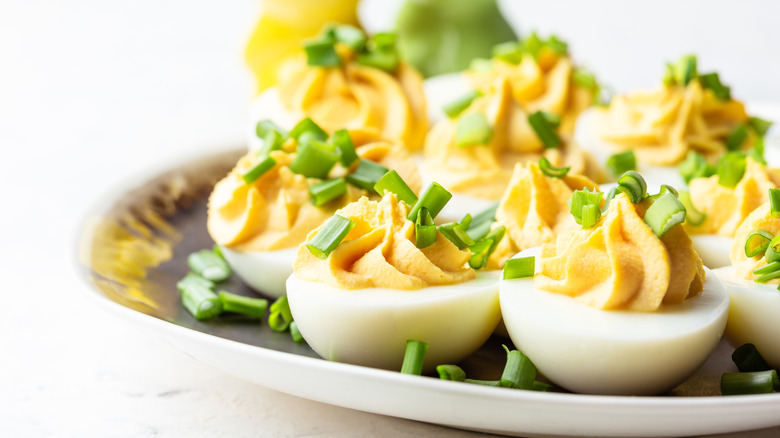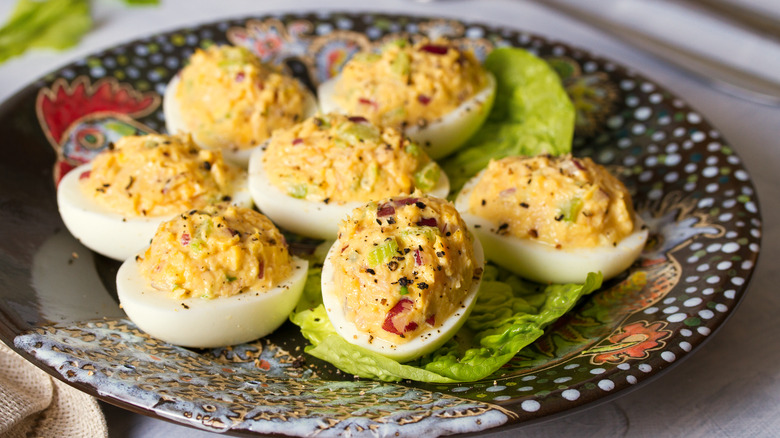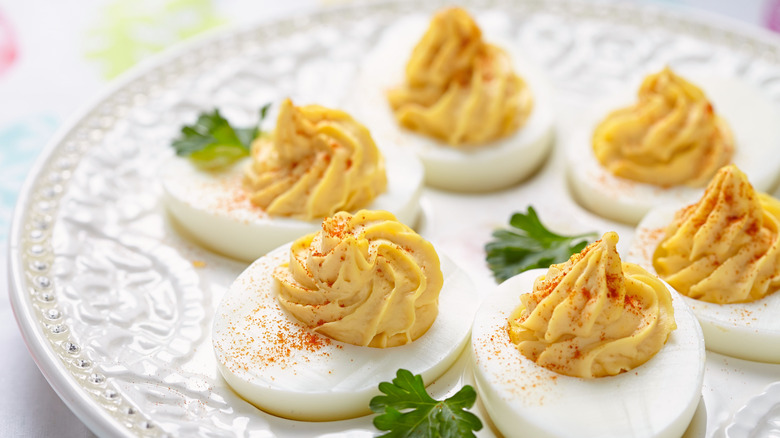How To Prevent Your Deviled Eggs From Weeping
While everyone has heard the phrase about crying over spilled milk, weeping deviled eggs does not make for a merry moment, either. Weeping, when referring to deviled eggs, means that liquid seeps out, causing the appearance to be overall wet, drippy, or watery. Weeping can appear as a sheen over either the whites or the yolk portion of the deviled eggs.
The first step to avoid weeping deviled eggs involves using proper cooking techniques. When eggs are cooked too quickly, over high heat, the protein seizes as it cools and water leeches out. To prevent this error, it is best to allow the eggs to cook slowly, shock them in ice water to stop the cooking process abruptly, and then allow them to cool completely before moving on to the next preparation step.
When assembling deviled eggs, another way to help avoid weeping is to make sure the halved whites are well-dried before piping the creamy yolk mixture into the center. In addition, it can be beneficial to wait until the last minute to prepare the dish to avoid environmental factors, like humidity, from potentially causing a weeping or another wet appearance issue. Other factors, like keeping the deviled eggs cool and out of direct sunlight, can assist in avoiding this sad, drippy phenomenon. Luckily, with proper care throughout the process, no one has to fret about weeping eggs ruining the appetizer table.
Choose yolk filling ingredients carefully to avoid weeping deviled eggs
While proper cooking techniques are the first step to avoiding weeping, experimenting with certain deviled egg ingredients, unfortunately, can result in a watery, sloppy appearance on the plate. Ingredients with a high water content, like tomatoes or cucumbers, can help create this wet scenario. If pickles, pimentos, or olives are used, it is best to dry those ingredients well before adding them to the mixture. When choosing ingredients to liven up the yolk mixture, it is important to keep the excess liquid to a minimum.
Crafting the yolk filling is about finding the right balance between flavor and texture. No one wants just mashed yolk. And keep in mind that too much mayonnaise can exacerbate a wet appearance. Spices and seasonings can bring considerable flavor without adding more moisture to the mix. Weeping deviled eggs can be avoided as long as a little thoughtfulness is folded into the mix.
This pantry staple can keep deviled egg filling from being runny
As the old saying goes, people eat with their eyes first, and runny, weepy deviled eggs certainly do not have an appetizing appearance. Luckily there is a handy trick to achieving the perfect filling consistency, aside from your egg cooking technique. And it's easy to do. To help absorb excess liquid, fold some potato flakes into the yolk mixture. A few spoonfuls of the dried flakes add starch and richness to the yolk mixture. Although it should not be overused, it can help make the yolk center less runny. It is best to use an unflavored variety since competing flavors can make for an unpleasant taste. But, if a flavored variety is the only option, consider building the other filling ingredients around it.
From proper cooking techniques to thoughtful use of ingredients, no one should ever have to be worried about weeping deviled eggs.


